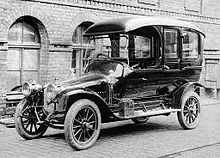Russo-Balt
This article needs additional citations for verification. (July 2008) |
 | |
| Founded | 1894 |
|---|---|
| Headquarters | Moscow, Russia |
| Website | russo-baltic |
Russo-Balt (sometimes Russobalt or Russo-Baltique) was one of the first Russian companies that produced cars between 1909 and 1923.



History
Riga factory
The Russo-Baltic Wagon Factory (German: Russisch-Baltische Waggonfabrik; Russian: Русско-Балтийский вагонный завод, RBVZ) was founded in 1874 in Riga, then a major industrial centre of Russian Empire. Originally the new company was a subsidiary of the Van der Zypen & Charlier company in Cologne-Deutz, Germany.
In 1894 the majority of its shares were sold to investors in Riga and St. Petersburg, among them local Baltic German merchants F. Meyer, K. Amelung, and Chr. Schroeder, as well as Schaje Berlin, a relative of Isaiah Berlin. The company eventually grew to 3,800 employees.[1]
Between 1909 and 1915 the cars were built at the railway car factory RBVZ. In 1915 the Riga factory was evacuated, with the equipment being transferred to St. Petersburg, Fili (Moscow) and Tver.[2]
Today in Riga, Latvia, there is a company named Russo-Balt that manufactures trailers.[3]
St Petersburg factory
In early 1912 company director M. V. Shidlovsky hired 22-year-old Igor Sikorsky as the chief engineer for RBVZ's new aircraft division in St. Petersburg. Sikorsky's airplane had recently won a military aircraft competition in Moscow. He brought several engineers with him to RBVZ, and agreed that the company would own his designs for the next five years.
This group quickly produced a series of airplanes. Among these were the S-5, S-7, S-9, S-10 (1913), S-11, S-12, S-16 (1915), S-20 (1916), Russky Vityaz (The Grand) (1913), a series named Il'ya Muromets starting in 1913,[4] and the Alexander Nevsky (1916).
Relatedly, in 1914, Shidlovsky was appointed commander of the newly formed EVK (Eskadra vozdushnykh korablei, Squadron of Flying Ships). This squadron flew Il'ya Muromets bombers during World War I.
The Bolshevik Revolution brought an end to the aircraft business. Sikorsky left for France in 1918.[5] Shidlovsky and his son were arrested in 1919, while attempting to go to Finland, and were murdered.[6]
After the 1917 revolution a second factory was opened in St. Petersburg, where they built armoured cars on chassis produced in Riga.
Moscow factory
In 1922, the production was moved from St. Petersburg to BTAZ in Moscow. The Moscow plant was evacuated to Kazan in 1941, leading to the establishment of the Kazan Aircraft Production Association.[7] The Moscow site later became home to the Khrunichev Space Center.[7]
Concept car

The brand "Руссо-Балт" was resurrected in 2006 by a group of German and Russian investors to propose a luxury concept car, the Russo-Baltique Impression, billed as a coupé with strong hints of European styling of the early 1930s. The car uses mechanical parts of Mercedes origin (Mercedes CL63 AMG), was first introduced at the 2006 Concours d'Elegance.
The car will be produced by the German company Gerg GmbH (or perhaps Russo-Baltique Engineering GmbH).[citation needed] Total production of 10 to 15 cars maximum is expected, with a production rate of 2 to 3 cars a year. The selling price would be around 50,000,000 rubles or 870,000 US dollars.
The current owner of the international trademark "Russo-Balt" is Russo-Balt, LLC (OOO), Moscow, Russia.[8]
List of products




Russo-Balt produced trucks, buses and cars, often more or less copies of cars from the German Rex-Simplex or Belgian Fondu Trucks.
Only two original cars have survived to the present day. One is a Russo-Balt fire engine built on truck chassis Type D in year 1912. Car is on display at the Riga Motor Museum in Latvia. Another one is Russo-Balt K12/20 from 1911, is shown at the Polytechnical Museum in Moscow, Russia.
Cars
- 24-30 (1909)
- Type C (1909)
- C24-30 (1909)
- C24-30 Faeton (≥ 1909)
- Landole C24-30 (1909)
- C24-40 (1913)
- C24-50 (1909/'10/'1/'2)
- C24-58 (1909/'10/'1/'2/'3)
- C24-30 (1909)
- Type K (1909)
- K12-20 (1909)
- Type E (1914)
- Impression (2006)
Military vehicles
- Type C (1912) (based on normal model)
- Blinded versions of different models (1914)
Trucks
See also
References
- ^ Henriksson, Anders (1983). The Tsar's Loyal Germans:The Riga German Community—Social Change and the Nationality Question, 1855–1905. Boulder, CO: East European Monographs. p. 122. ISBN 0-88033-020-1.
- ^ Davies, R. W. From Tsarism to the New Economic Policy. p. 194.
- ^ "PRODUCTION COMPANY RUSSO-BALT - EXIM". www.exim.lv.
- ^ Hunt, William E. (1999). 'Heelicopter': Pioneering with Igor Sikorsky. Swan Hill Press. pp. 11–19. ISBN 1-85310-768-9.
- ^ "A company history of the Sikorsky Corp". Fundinguniverse.com. Archived from the original on 2011-09-10. Retrieved 2011-10-30.
{{cite web}}: Unknown parameter|deadurl=ignored (|url-status=suggested) (help) - ^ Finne, K.N. (1987). Igor Sikorsky: The Russian Years. translated and adapted by Von Hardesty; Carl J. Bobrow and Von Hardesty, eds. Washington, D.C.: Smithsonian Institution Press. p. 39. ISBN 0-87474-274-9.
- ^ a b "4. Предприятия и заводы оборонной промышленности". Военный паритет. Archived from the original on 29 July 2017. Retrieved 15 May 2018.
{{cite web}}: Unknown parameter|deadurl=ignored (|url-status=suggested) (help) - ^ "RUSSO-BALT Trademark Information". Archived from the original on 2017-10-24.
{{cite web}}: Unknown parameter|deadurl=ignored (|url-status=suggested) (help)
External links
- Defunct motor vehicle manufacturers of Russia
- Motor vehicle manufacturers of Latvia
- Defunct aircraft manufacturers of Russia
- Companies of Latvia
- Concept cars
- Manufacturing companies established in 1874
- Vehicle manufacturing companies disestablished in 1923
- 1874 establishments in Latvia
- 1923 disestablishments in Russia
